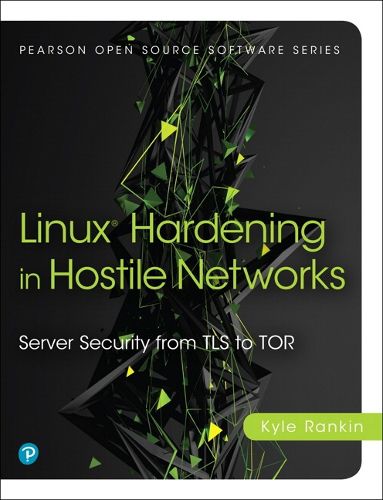Readings Newsletter
Become a Readings Member to make your shopping experience even easier.
Sign in or sign up for free!
You’re not far away from qualifying for FREE standard shipping within Australia
You’ve qualified for FREE standard shipping within Australia
The cart is loading…






In an age of mass surveillance, when advanced cyberwarfare weapons rapidly migrate into every hacker’s toolkit, you can’t rely on outdated security methods-especially if you’re responsible for Internet-facing services. In Linux ® Hardening in Hostile Networks, Kyle Rankin helps you to implement modern safeguards that provide maximum impact with minimum effort and to strip away old techniques that are no longer worth your time.
Rankin provides clear, concise guidance on modern workstation, server, and network hardening, and explains how to harden specific services, such as web servers, email, DNS, and databases. Along the way, he demystifies technologies once viewed as too complex or mysterious but now essential to mainstream Linux security. He also includes a full chapter on effective incident response that both DevOps and SecOps can use to write their own incident response plan.
Each chapter begins with techniques any sysadmin can use quickly to protect against entry-level hackers and presents intermediate and advanced techniques to safeguard against sophisticated and knowledgeable attackers, perhaps even state actors. Throughout, you learn what each technique does, how it works, what it does and doesn’t protect against, and whether it would be useful in your environment.
Apply core security techniques including 2FA and strong passwords
Protect admin workstations via lock screens, disk encryption, BIOS passwords, and other methods
Use the security-focused Tails distribution as a quick path to a hardened workstation
Compartmentalize workstation tasks into VMs with varying levels of trust
Harden servers with SSH, use apparmor and sudo to limit the damage attackers can do, and set up remote syslog servers to track their actions
Establish secure VPNs with OpenVPN, and leverage SSH to tunnel traffic when VPNs can’t be used
Configure a software load balancer to terminate SSL/TLS connections and initiate new ones downstream
Set up standalone Tor services and hidden Tor services and relays
Secure Apache and Nginx web servers, and take full advantage of HTTPS
Perform advanced web server hardening with HTTPS forward secrecy and ModSecurity web application firewalls
Strengthen email security with SMTP relay authentication, SMTPS, SPF records, DKIM, and DMARC
Harden DNS servers, deter their use in DDoS attacks, and fully implement DNSSEC
Systematically protect databases via network access control, TLS traffic encryption, and encrypted data storage
Respond to a compromised server, collect evidence, and prevent future attacks
$9.00 standard shipping within Australia
FREE standard shipping within Australia for orders over $100.00
Express & International shipping calculated at checkout
In an age of mass surveillance, when advanced cyberwarfare weapons rapidly migrate into every hacker’s toolkit, you can’t rely on outdated security methods-especially if you’re responsible for Internet-facing services. In Linux ® Hardening in Hostile Networks, Kyle Rankin helps you to implement modern safeguards that provide maximum impact with minimum effort and to strip away old techniques that are no longer worth your time.
Rankin provides clear, concise guidance on modern workstation, server, and network hardening, and explains how to harden specific services, such as web servers, email, DNS, and databases. Along the way, he demystifies technologies once viewed as too complex or mysterious but now essential to mainstream Linux security. He also includes a full chapter on effective incident response that both DevOps and SecOps can use to write their own incident response plan.
Each chapter begins with techniques any sysadmin can use quickly to protect against entry-level hackers and presents intermediate and advanced techniques to safeguard against sophisticated and knowledgeable attackers, perhaps even state actors. Throughout, you learn what each technique does, how it works, what it does and doesn’t protect against, and whether it would be useful in your environment.
Apply core security techniques including 2FA and strong passwords
Protect admin workstations via lock screens, disk encryption, BIOS passwords, and other methods
Use the security-focused Tails distribution as a quick path to a hardened workstation
Compartmentalize workstation tasks into VMs with varying levels of trust
Harden servers with SSH, use apparmor and sudo to limit the damage attackers can do, and set up remote syslog servers to track their actions
Establish secure VPNs with OpenVPN, and leverage SSH to tunnel traffic when VPNs can’t be used
Configure a software load balancer to terminate SSL/TLS connections and initiate new ones downstream
Set up standalone Tor services and hidden Tor services and relays
Secure Apache and Nginx web servers, and take full advantage of HTTPS
Perform advanced web server hardening with HTTPS forward secrecy and ModSecurity web application firewalls
Strengthen email security with SMTP relay authentication, SMTPS, SPF records, DKIM, and DMARC
Harden DNS servers, deter their use in DDoS attacks, and fully implement DNSSEC
Systematically protect databases via network access control, TLS traffic encryption, and encrypted data storage
Respond to a compromised server, collect evidence, and prevent future attacks